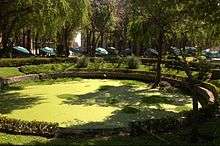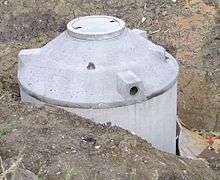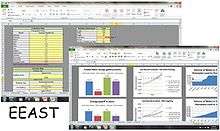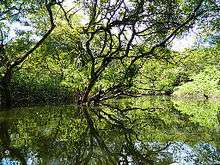Rainwater harvesting


Rainwater harvesting is the accumulation and deposition of rainwater for reuse on-site, rather than allowing it to run off. Rainwater can be collected from rivers or roofs, and in many places the water collected is redirected to a deep pit (well, shaft, or borehole), a reservoir with percolation, or collected from dew or fog with nets or other tools. Its uses include water for gardens, livestock, irrigation, domestic use with proper treatment, and indoor heating for houses etc. The harvested water can also be used as drinking water, longer-term storage and for other purposes such as groundwater recharge.
Advantages
Rainwater harvesting provides an independent water supply during regional water restrictions and in developed countries is often used to supplement the main supply. It provides water when there is a drought, can help mitigate flooding of low-lying areas, and reduces demand on wells which may enable groundwater levels to be sustained. It also helps in the availability of potable water as rainwater is substantially free of salinity and other salts. Application of rainwater harvesting in urban water system provides a substantial benefit for both water supply and wastewater subsystems by reducing the need for clean water in water distribution system, less generated stormwater in sewer system,[1] as well as a reduction in stormwater runoff polluting freshwater bodies.
There has been a large body of work focused on the development of Life Cycle Assessment and Life Cycle Costing methodologies to assess the level of environmental impacts and money that can be saved by implementing rainwater harvesting systems.
More development and knowledge is required to understand the benefits rainwater harvesting can provide to agriculture. Many countries especially those with an arid environment use rainwater harvesting as a cheap and reliable source of clean water.[2] To enhance irrigation in arid environments, ridges of soil are constructed in order to trap and prevent rainwater from running down hills and slopes. Even in periods of low rainfall, enough water is collected in order for crops to grow.[3] Water can be collected from roofs, dams, and ponds can be constructed in order to hold large quantities of rainwater so that even on days where there is little to no rainfall, there is enough available to irrigate crops.[3]
Quality
The concentration of contaminants is reduced significantly by diverting the initial flow of run-off water to waste.[4] Improved water quality can also be obtained by using a floating draw-off mechanism (rather than from the base of the tank) and by using a series of tanks, with draw from the last in series. Pre-filtration is a common practice used in the industry to ensure that the water entering the tank is free of large sediment. Pre-filtration is important to keep the system healthy.
Conceptually, a water supply system should match the quality of water with the end use. However, in most of the developed world high quality potable water is used for all end uses. This approach wastes money and energy and imposes unnecessary impacts to the environment. Supplying rainwater that has gone through preliminary filtration measures for non-potable water uses, such as toilet flushing, irrigation, and laundry, may be a significant part of a sustainable water management strategy.
System setup
Rainwater harvesting systems can range in complexity, from systems that can be installed with minimal skills, to automated systems that require advanced setup and installation. The basic Rainwater harvesting system is more of a plumbing job than a technical job as all the outlets from the building terrace are connected through a pipe to an underground tank that stores water.
Systems are ideally sized to meet the water demand throughout the dry season since it must be big enough to support daily water consumption. Specifically, the rainfall capturing area such as a building roof must be large enough to maintain adequate flow. The water storage tank size should be large enough to contain the captured water.
For low-tech systems, there are many low-tech methods used to capture rainwater: rooftop systems, surface water capture, and pumping the rainwater that has already soaked into the ground or captured in reservoirs and storing it into tanks (cisterns).
Before a rainwater harvesting system is built, it is helpful to use digital tools. For instance, if you want to detect if a region has a high rainwater harvesting potential, rainwater harvesting GIS maps can be made using an online interactive tool. Or if you need to estimate how much water is needed to fulfill a community's water needs, the Rain is Gain tool helps with this. Tools like these can save time and money before a commitment to build a system is undertaken, in addition to making the project sustainable and last a long time.
Life Cycle Assessment: Design for Environment

Contemporary system designs require an analysis of not only the economic and technical performance of a system, but also the environmental performance. Life Cycle Assessment is a methodology used to evaluate the environmental impacts of a precut or systems, from cradle-to-grave of its' lifetime. Devkota et al.,[5][6] developed such a methodology for rainwater harvesting, and found that the building design (e.g., dimensions) and function (e.g., educational, residential, etc.) play critical roles in the environmental performance of the system. The Economic and Environmental Analysis of Sanitations Technologies, EEAST model evaluates the greenhouse gas emissions and cost of such systems over the lifetime of a variety of building types.
To address the functional parameters of rainwater harvesting systems, a new metric was developed - the demand to supply ratio (D/S) - identifying the ideal building design (supply) and function (demand) in regard to the environmental performance of rainwater harvesting for toilet flushing. With the idea that supply of rainwater not only saves the potable water, but also saves the stormwater entering the combined sewer network (thereby requiring treatment), the savings in environmental emissions were higher if the buildings are connected to a combined sewer network compared to separate one.[6]
Rain water harvesting by freshwater flooded forests
Rain water harvesting is possible by growing fresh water flooded forests without losing the income from the used /submerged land.[7] The main purpose of the rain water harvesting is to utilize the locally available rain water to meet water requirements throughout the year without the need of huge capital expenditure. This would facilitate availability of uncontaminated water for domestic, industrial and irrigation needs.
New approaches
Instead of using the roof for catchment, the RainSaucer, which looks like an upside down umbrella, collects rain straight from the sky. This decreases the potential for contamination and makes potable water for developing countries a potential application.[8] Other applications of this free standing rainwater collection approach are sustainable gardening and small plot farming.[9]
A Dutch invention called the Groasis Waterboxx is also useful for growing trees with harvested and stored dew and rainwater.
Traditionally, storm water management using detention basins served a single purpose. However, Optimized Real-Time Control (OptiRTC) lets this infrastructure double as a source of rainwater harvesting without compromising the existing detention capacity.[10] This has been used in the EPA headquarters to evacuate stored water prior to storm events, thus reducing wet weather flow while ensuring water availability for later reuse. This has the benefit of increasing water quality released and decreasing the volume of water released during combined sewer overflow events.[11][12]
Generally, check dams are constructed across the streams to enhance the percolation of surface water in to the sub soil strata. The water percolation in the water impounded area of the check dams, can be enhanced artificially many folds by loosening the sub soil strata / overburden by using ANFO explosives as used in open cast mining. Thus local aquifers can be recharged quickly by using the available surface water fully for using in the dry season.
History
Earlier
Around the third century BC, the farming communities in Balochistan (now located in Pakistan, Afghanistan and Iran), and Kutch, India, used rainwater harvesting for agriculture and many uses also.[13] In ancient Tamil Nadu , rainwater harvesting was done by Chola kings.[14] Rainwater from the Brihadeeswarar temple (located in Balaganpathy Nagar, Thanjavur, India) was collected in Shivaganga tank.[15] During the later Chola period, the Vīrānam tank was built (1011 to 1037 CE) in Cuddalore district of Tamil Nadu to store water for drinking and irrigation purposes. Vīrānam is a 16 km (9.9 mi) long tank with a storage capacity of 1,465,000,000 cubic feet (41,500,000 m3).
Rainwater harvesting was done in the Indian states of Madhya Pradesh, Maharashtra, and Chhattisgarh in the olden days. Ratanpur, in the state of Chhattisgarh, had around 150 ponds. Most of the tanks or ponds were utilized in agriculture works.
It is a little know fact that the town of Venice depended for centuries on rainwater harvesting. The lagoon which surrounds Venice is made of brackish water which is not suitable for human drinking. The ancient inhabitants of Venice established a system of rainwater collection which was based on man-made insulated collection wells.[16] Water would percolate down the specially designed stone flooring, and be filtered by a layer of sand, then collecting at the bottom of the well. Later, as Venice acquired territories on the mainland, it started to import water by boat from local rivers, but the wells remained in use, and were especially important in time of war when access to the mainland water could be blocked by an assailant.
Current use
- In China and Brazil rooftop rainwater harvesting is being practiced for providing drinking water, domestic water, water for livestock, water for small irrigation and a way to replenish groundwater levels. Gansu province in China and semi-arid north east Brazil have the largest rooftop rainwater harvesting projects ongoing.
- In Bermuda, the law requires all new construction to include rainwater harvesting adequate for the residents.
- The U.S. Virgin Islands have a similar law.
- In Senegal and Guinea-Bissau, the houses of the Diola-people are frequently equipped with homebrew rainwater harvesters made from local, organic materials.
- In the Irrawaddy Delta of Myanmar, the groundwater is saline and communities rely on mud-lined rainwater ponds to meet their drinking water needs throughout the dry season. Some of these ponds are centuries old and are treated with great reverence and respect.
- In the United States: until 2009 in Colorado, water rights laws almost completely restricted rainwater harvesting; a property owner who captured rainwater was deemed to be stealing it from those who have rights to take water from the watershed. Now, residential well owners that meet certain criteria may obtain a permit to install a rooftop precipitation collection system (SB 09-080).[17] Up to 10 large scale pilot studies may also be permitted (HB 09-1129).[18] The main factor in persuading the Colorado Legislature to change the law was a 2007 study that found that in an average year, 97% of the precipitation that fell in Douglas County, in the southern suburbs of Denver, never reached a stream—it was used by plants or evaporated on the ground. In Colorado you cannot even drill a water well unless you have at least 35 acres (14 ha). In New Mexico, rainwater catchment is mandatory for new dwellings in Santa Fe.[19] Texas offers a sales tax exemption on the purchase of rainwater harvesting equipment. Both Texas[20] and Ohio allow the practice even for potable purposes. Oklahoma passed the Water for 2060 Act in 2012, to promote pilot projects for rainwater and graywater use among other water saving techniques.[21]
- In Beijing, some housing societies are now adding rain water in their main water sources after proper treatment.
- In Ireland, Professor Micheal Mcginley established a project to design a rain water harvesting prototype in the Biosystems design Challenge Module at University College Dublin
Canada
A number of Canadians have started implementing rainwater harvesting systems for use in stormwater reduction, irrigation, laundry, and lavatory plumbing. Substantial reform to Canadian law since the mid 2000s has increased the use of this technology in agricultural, industrial, and residential use; but ambiguity remains amongst legislation in many provinces. Bylaws and local municipal codes often regulate rainwater harvesting.
India
- Tamil Nadu: Tamil Nadu was the first state to make Rainwater Harvesting compulsory for every building to avoid groundwater depletion. The scheme was launched in 2001 and has been implemented in all rural areas of Tamil Nadu. We can see posters all over Tamil Nadu including Rural areas to create awareness about harvesting RainwaterTN Govt site. It gave excellent results within five years, and slowly every state took it as role model. Since its implementation, Chennai saw a 50 percent rise in water level in five years and the water quality significantly improved.[22]
- Karnataka: In Bangalore it is mandatory for adoption of rain water harvesting for every owner or the occupier of a building having the sital area measuring 60 ft (18.3 m) X 40 ft (12.2 m) and above and for newly constructed building measuring 30 ft (9.1 m) X 40 ft (12.2 m) and above dimension. In this regard BWSSB has initiated and constructed “Rain Water Harvesting Theme Park” in the name of Sir. M. Visvesvaraya in 1.2 acres (4,900 m2) land situated at Jayanagar, Bangalore. In this park 26 different type of Rain Water Harvesting models are demonstrated along with the water conservation tips. The Auditorium on the first floor is set up with Green Air conditioning system and the same will be utilized to arrange the meeting and showing the video clip about the rain water harvesting to students as well as general public.[23]
- Rajasthan: In Rajasthan, rainwater harvesting has traditionally been practiced by the people of the Thar Desert. There are many ancient water harvesting systems in Rajasthan, which have now been revived.[24] Water harvesting systems are widely used in other areas of Rajasthan as well, for example the chauka system from the Jaipur district.[25]
- Kerala: Main article: Rainwater harvesting in Kerala
- Maharashtra: At present, in Pune, rainwater harvesting is compulsory for any new housing society to be registered.
- In Mumbai city in Maharashtra rain water harvesting is being considered as a good solution to solve water crisis.
The Mumbai city council is planning to make rainwater harvesting mandatory for large societies.[26] An attempt has been made at the Department of Chemical Engineering, IISc, Bangalore to harvest rainwater using upper surface of a solar still, which was used for water distillation[27]
Israel
The Southwest Center for the Study of Hospital and Healthcare Systems in cooperation with Rotary International is sponsoring a rainwater harvesting model program across the country. The first rainwater catchment system was installed at an elementary school in Lod, Israel. The project is looking to expand to Haifa in its third phase. The Southwest Center has also partnered with the Water Resources Action Project (WRAP) of Washington D.C. WRAP currently has rainwater harvesting projects in the West Bank. Rainwater harvesting systems are being installed in local schools for the purpose of educating schoolchildren about water conservation principles and bridging divides between people of different religious and ethnic backgrounds all while addressing the water scarcity issue that the Middle East faces.[28]
New Zealand
Although New Zealand has plentiful rainfall in the West and South, for much of the country, rain water harvesting is the normal practice for most rural housing and is encouraged by most councils [29]
Sri Lanka
Rainwater harvesting has been a popular method of obtaining water for agriculture and for drinking purposes in rural homes. The legislation to promote rainwater harvesting was enacted through the Urban Development Authority (Amendment) Act, No. 36 of 2007.[30] Lanka rainwater harvesting forum[31] is leading the Sri Lanka's initiative.
South Africa
The South African Water Research Commission has supported research into rainwater harvesting. Reports on this research are available on their 'Knowledge Hub'.[32] Studies in arid, semi-arid and humid regions have confirmed that techniques such as mulching, pitting, ridging and modified run-on plots are effective for small-scale crop production.[33]
United Kingdom
In the United Kingdom, water butts are often found in domestic gardens and on allotments to collect rainwater, which is then used to water the garden. However, the British government's Code For Sustainable Homes encouraged fitting large underground tanks to new-build homes to collect rainwater for flushing toilets, watering and washing. Ideal designs had the potential to reduce demand on mains water supply by half. The code was revoked in 2015.
United States
- Colorado: Until 2009, water rights laws almost completely restricted rainwater harvesting; a property owner who captured rainwater was deemed to be stealing it from those who have rights to take water from the watershed. Now, residential well owners that meet certain criteria may obtain a permit to install a rooftop precipitation collection system (SB 09-080).[34] Up to 10 large scale pilot studies may also be permitted (HB 09-1129).[35] The main factor in persuading the Colorado Legislature to change the law was a 2007 study that found that in an average year, 97% of the precipitation that fell in Douglas County, in the southern suburbs of Denver, never reached a stream—it was used by plants or evaporated on the ground. In Colorado you cannot even drill a water well unless you have at least 35 acres (14 ha)
- New Mexico: In New Mexico, rainwater catchment is mandatory for new dwellings in Santa Fe.[19]
- Texas offers a sales tax exemption on the purchase of rainwater harvesting equipment. Both Texas[36] and Ohio allow the practice even for potable purposes.
- Oklahoma passed the Water for 2060 Act in 2012, to promote pilot projects for rainwater and graywater use among other water saving techniques.[21]
Non-traditional
- In 1992, American artist Michael Jones McKean created an artwork in Omaha, Nebraska at the Bemis Center for Contemporary Art that created a fully sustainable rainbow in the Omaha skyline. The project collected thousands of gallons of rainwater storing the water in six daisy-chained 12,000 gallons tanks.[37] The massive logistical undertaking, during its 5-month span, was one of the largest urban rainwater harvesting sites in the American Mid-West.
See also
- Atmospheric water generator
- Water conservation
- Peak water
- Nelapattu Bird Sanctuary
- Deepwater rice
- Air well (condenser)
- Detention basin
- Retention basin
References
- ↑ Behzadian, k; Kapelan, Z (2015). "Advantages of integrated and sustainability based assessment for metabolism based strategic planning of urban water systems". Science of The Total Environment. Elsevier. 527-528: 220–231. doi:10.1016/j.scitotenv.2015.04.097.
- ↑ Zhu, Qiang; et al. (2015). Rainwater Harvesting for Agriculture and Water Supply. Beijing: Springer. p. 20. ISBN 978-981-287-964-6.
- 1 2 http://practicalaction.org/rainwater-harvesting-8
- ↑ New Scientist, 3 April 1999
- ↑ Devkota, Jay (2013). "Development and application of EEAST: A life cycle based model for use of harvested rainwater and composting toilets in buildings". Journal of Environmental Management.
- 1 2 Devkota, Jay (2015). "Life cycle based evaluation of harvested rainwater use in toilets and for irrigation.". Journal of Cleaner Production.
- ↑ Rain water harvesting by fresh water flooded forests
- ↑ "Harvesting rainwater for more than greywater". SmartPlanet. Retrieved 13 November 2014.
- ↑ Kumar, Ro. "Collect up to 10 gallons of water per inch of rain with Rainsaucers' latest standalone rainwater catchment". LocalBlu. Retrieved 11 February 2013.
- ↑ "Rainwater Harvesting - Controls in the Cloud". SmartPlanet. Retrieved 11 January 2015.
- ↑ O'Brien, Sara Ashley. "The Tech Behind Smart Cities - Eliminating Water Pollution". CNN Money. Retrieved 13 November 2014.
- ↑ Braga, Andrea. "Making Green Work, and Work Harder" (PDF). Geosyntec. p. 5. Retrieved 30 November 2014.
- ↑ "Rain water Harvesting". Tamilnadu State Government, India. Retrieved 23 January 2012.
- ↑ "Believes in past, lives in future". The Hindu. India. 17 July 2010.
- ↑ "Rare Chola inscription found near Big Temple". The Hindu. India. 24 August 2003.
- ↑ "Venetian wells".
- ↑ "Rainwater Collection in Colorado" (PDF). Colorado water law, notices. Colorado Division of Water Resources. Retrieved 2012-03-24.
- ↑ "Criteria and Guidelines for the "Rainwater Harvesting"" (PDF). Pilot Project Program. Colorado Water Conservation Board (CWCB). January 28, 2010. Retrieved 2012-03-24.
- 1 2 Johnson, Kirk (June 28, 2009). "It's Now Legal to Catch a Raindrop in Colorado". The New York Times. Retrieved 2009-06-30.
Precipitation, every last drop or flake, was assigned ownership from the moment it fell in many Western states, making scofflaws of people who scooped rainfall from their own gutters. In some instances, the rights to that water were assigned a century or more ago.
- ↑ "82(R) H.B. No. 3391. Act relating to rainwater harvesting and other water conservation initiatives. † went into effect on September 1, 2011". 82nd Regular Session. Texas Legislature Online. Retrieved 8 February 2013.
- 1 2 "State Rainwater Harvesting Statutes, Programs and Legislation". NCSL. Retrieved 7 February 2013.
- ↑ "Tamil Nadu praised as role model for Rainwater Harvesting". Hindu.com. 2011-09-29. Retrieved 2012-03-24.
- ↑ "Rain Water Harvesting BWSSB - Bangalore Water Supply and Sewerage Board". bwssb.gov.in.
- ↑ "Ancient water harvesting systems in Rajasthan". Rainwaterharvesting.org. Retrieved 2012-03-24.
- ↑ "Chauka System". rainwaterharvesting.org: technology: rural: improvised. Centre for Science and Environment. Retrieved 2013-10-23.
- ↑ http://www.mid-day.com/articles/bmc-to-make-rainwater-harvesting-mandatory-for-large-societies/17110192
- ↑ Anjaneyulu, L.; Kumar, E. Arun; Sankannavar, Ravi; Rao, K. Kesava (13 June 2012). "Defluoridation of Drinking Water and Rainwater Harvesting Using a Solar Still". Industrial & Engineering Chemistry Research. 51 (23): 8040–8048. doi:10.1021/ie201692q.
- ↑ http://www.lodrainwater.org. Missing or empty
|title=(help) - ↑ "Rainwater tanks". Greater Wellington Regional Council. 28 April 2016. Retrieved 31 August 2016.
- ↑ "Parliament Of The Democratic Socialist Republic of Sri Lanka" (PDF).
- ↑ "Lanka Rain Water Harvesting forum (LRWHF)".
- ↑ "Rainwater harvesting". www.wrc.org.za. South African Water Research Commission. Retrieved 27 August 2014.
- ↑ Everson C; Everson TM; Modi AT; Csiwila D; Fanadzo M; Naiken V; Auerbach RMB; Moodley M; Mtshali SM; Dladla R (2011). Sustainable techniques and practices for water harvesting and conservation and their effective application in resource-poor agricultural production through participatory adaptive research : report to the Water Research Commission (PDF). Gezina [South Africa]: Water Research Commission. p. 89. ISBN 978-1-4312-0185-3. Retrieved 27 August 2014.
- ↑ "Rainwater Collection in Colorado" (PDF). Colorado water law, notices. Colorado Division of Water Resources. Retrieved 2012-03-24.
- ↑ "Criteria and Guidelines for the "Rainwater Harvesting"" (PDF). Pilot Project Program. Colorado Water Conservation Board (CWCB). January 28, 2010. Retrieved 2012-03-24.
- ↑ "82(R) H.B. No. 3391. Act relating to rainwater harvesting and other water conservation initiatives. † went into effect on September 1, 2011". 82nd Regular Session. Texas Legislature Online. Retrieved 8 February 2013.
- ↑ http://www.therainbow.org/overview/
